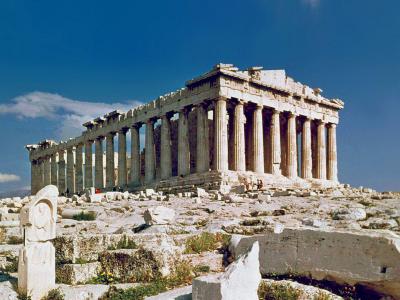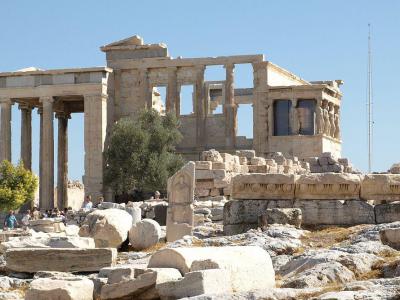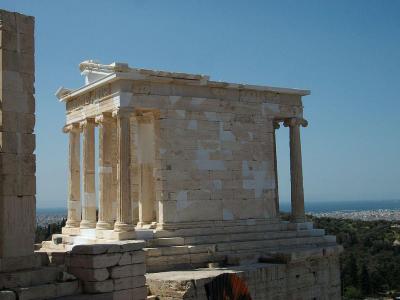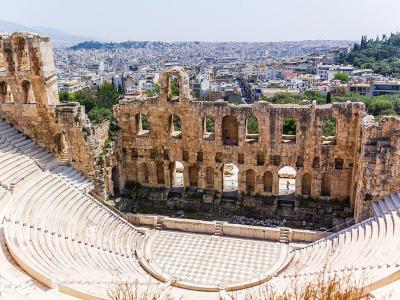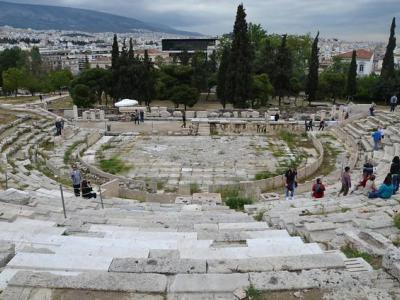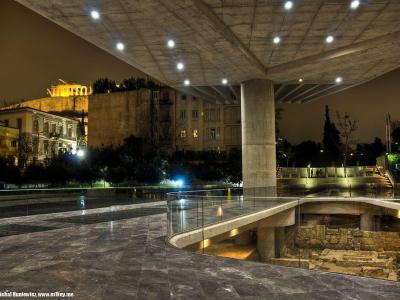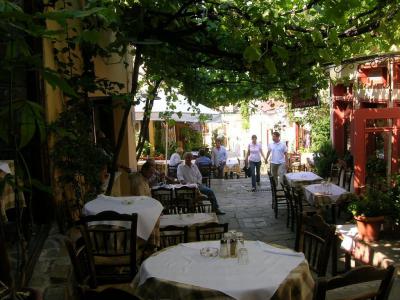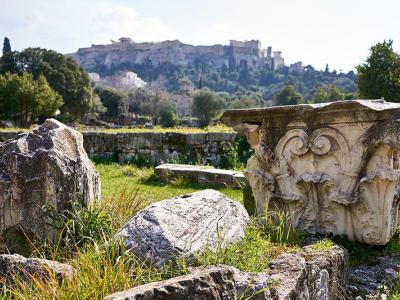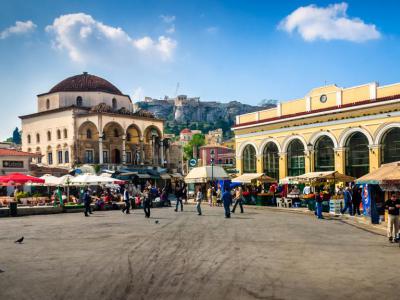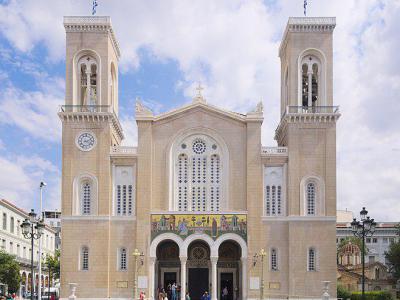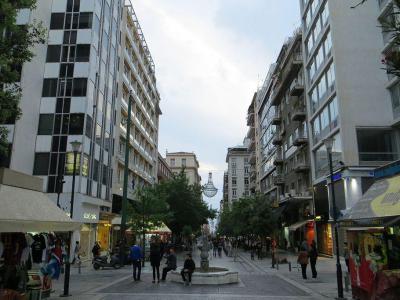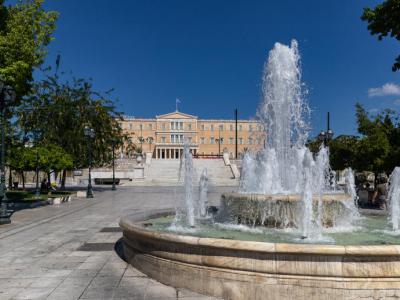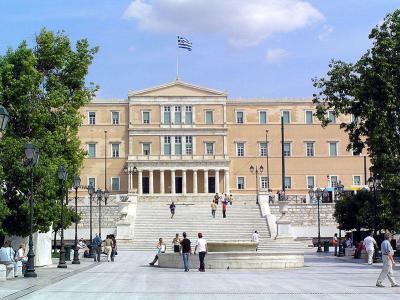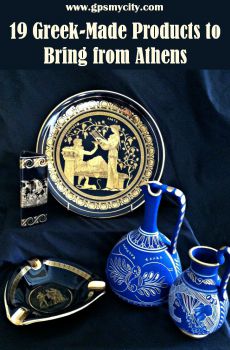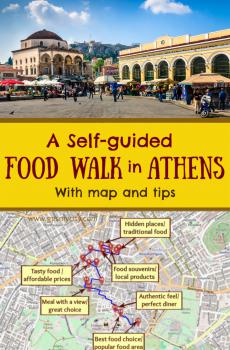Audio Guide: Athens Introduction Walking Tour (Self Guided), Athens
Athens, the cradle of Western Civilization and one of Europe's oldest cities, originated between the 4th and the 3rd millennia BC. The story of Athens stems from a mythological contest between the goddess of wisdom and warfare, Athena, and the god of the sea, Poseidon. Both deities vied to become the city's patron. Poseidon's gift of a saltwater spring was deemed impractical, whereas Athena's olive tree, providing food, fuel, and building material, proved invaluable and thus secured her the city's patronage and name.
During the 5th and the 4th centuries BC, Athens reached its cultural and intellectual peak, hosting seminal figures like playwrights Aeschylus and Euripides, and philosophers Plato and Socrates. The city experienced declines post-Roman Empire and by the early 19th century had a mere population of under 5,000. However, its resurgence as Greece's capital, in 1832, and subsequent growth after World War II, fueled by migration and the country's entry into the European Union, marked significant comebacks, reinstating Athens as a pivotal cultural and historical hub.
The city's heart lies in the magnificent rock of Acropolis (which means "high city" in Greek). Here, the Parthenon stands as an enduring symbol of ancient Greek civilization and democratic ideals. Not far from this iconic temple is the Erechtheion, famous for its Caryatids, the statuesque female figures that support the southern porch. Nearby, the Temple of Athena Nike exemplifies classical grace, celebrating Athena as the bringer of victory.
Descending the Acropolis, the Odeon of Herodes Atticus still resonates with the sounds of ancient dramas and modern performances. Adjacent to it is the Theater of Dionysus, where the plays of Sophocles and Euripides once premiered. At the foot of the Acropolis, the Acropolis Museum houses masterpieces of Athenian art, offering a modern context for the ancient marvels.
North of the Acropolis, the quaint Anafiotika neighborhood, with its island-like charm, leads visitors through winding paths to the bustling Plaka Stairs, lined with vibrant taverns and shops. The columned walkway Stoa of Attalos, restored to its former glory, introduces the Ancient Agora Museum, where Athenian democracy once took shape. This ancient marketplace, a former hub of civic activity, is also home to the well-preserved Temple of Hephaestus, dedicated to the god of metallurgy.
The vibrant Monastiraki Square, with its eclectic flea market, and Pandrossou Street Market offer a plethora of shopping and culinary experiences.
We invite you to dive into the historic metropolis of Athens and reveal some of its timeless stories and hidden corners. Embark on this self-guided walk and prepare yourself for an unforgettable journey!
During the 5th and the 4th centuries BC, Athens reached its cultural and intellectual peak, hosting seminal figures like playwrights Aeschylus and Euripides, and philosophers Plato and Socrates. The city experienced declines post-Roman Empire and by the early 19th century had a mere population of under 5,000. However, its resurgence as Greece's capital, in 1832, and subsequent growth after World War II, fueled by migration and the country's entry into the European Union, marked significant comebacks, reinstating Athens as a pivotal cultural and historical hub.
The city's heart lies in the magnificent rock of Acropolis (which means "high city" in Greek). Here, the Parthenon stands as an enduring symbol of ancient Greek civilization and democratic ideals. Not far from this iconic temple is the Erechtheion, famous for its Caryatids, the statuesque female figures that support the southern porch. Nearby, the Temple of Athena Nike exemplifies classical grace, celebrating Athena as the bringer of victory.
Descending the Acropolis, the Odeon of Herodes Atticus still resonates with the sounds of ancient dramas and modern performances. Adjacent to it is the Theater of Dionysus, where the plays of Sophocles and Euripides once premiered. At the foot of the Acropolis, the Acropolis Museum houses masterpieces of Athenian art, offering a modern context for the ancient marvels.
North of the Acropolis, the quaint Anafiotika neighborhood, with its island-like charm, leads visitors through winding paths to the bustling Plaka Stairs, lined with vibrant taverns and shops. The columned walkway Stoa of Attalos, restored to its former glory, introduces the Ancient Agora Museum, where Athenian democracy once took shape. This ancient marketplace, a former hub of civic activity, is also home to the well-preserved Temple of Hephaestus, dedicated to the god of metallurgy.
The vibrant Monastiraki Square, with its eclectic flea market, and Pandrossou Street Market offer a plethora of shopping and culinary experiences.
We invite you to dive into the historic metropolis of Athens and reveal some of its timeless stories and hidden corners. Embark on this self-guided walk and prepare yourself for an unforgettable journey!
How it works: Download the app "GPSmyCity: Walks in 1K+ Cities" from Apple App Store or Google Play Store to your mobile phone or tablet. The app turns your mobile device into a personal tour guide and its built-in GPS navigation functions guide you from one tour stop to next. The app works offline, so no data plan is needed when traveling abroad.
Athens Introduction Walking Tour Map
Guide Name: Athens Introduction Walking Tour
Guide Location: Greece » Athens (See other walking tours in Athens)
Guide Type: Self-guided Walking Tour (Sightseeing)
# of Attractions: 16
Tour Duration: 3 Hour(s)
Travel Distance: 4.2 Km or 2.6 Miles
Author: emily
Sight(s) Featured in This Guide:
Guide Location: Greece » Athens (See other walking tours in Athens)
Guide Type: Self-guided Walking Tour (Sightseeing)
# of Attractions: 16
Tour Duration: 3 Hour(s)
Travel Distance: 4.2 Km or 2.6 Miles
Author: emily
Sight(s) Featured in This Guide:
- Parthenon
- Erechtheion
- Temple of Athena Nike
- Odeon of Herodes Atticus
- Theater of Dionysus
- Acropolis Museum
- Anafiotika and Plaka Stairs
- Stoa of Attalos and Ancient Agora Museum
- Ancient Agora of Athens
- Temple of Hephaestus
- Monastiraki Square
- Pandrossou Street Market
- Metropolitan Cathedral
- Ermou Street
- Syntagma Square (Constitution Square)
- Hellenic Parliament House
1) Parthenon (must see)
Presiding over the Acropolis like a timeless guardian of Athens, the Parthenon is one of the finest and most recognizable examples of classical architecture. This 5th-century BC temple was the brainchild of Pericles, the man who decided Athens needed an upgrade-preferably in glorious white Pentelic marble.
Replacing an older sanctuary, the Parthenon was dedicated to Athena, the city's patron goddess, whose grand 12-meter-tall statue, adorned in ivory and gold, once dazzled anyone lucky enough to lay eyes on it. More than just a temple, the Parthenon was a statement piece-loud and clear-about Athens' dominance following its victories in the Persian Wars and its leading role in the Delian League (uniting under its umbrella equal city-states against Persia). In other words, it wasn’t just about worship; it was about showing off.
Designed in the Doric style, the temple was built to withstand the test of time-but history had other plans. Over the centuries, it transformed from a Greek temple to a Byzantine church, then a Turkish mosque, and finally, in 1687, into a really unlucky storage facility for gunpowder. That decision ended about as well as you'd expect when the Venetians decided to bombard the Acropolis, causing a spectacular explosion. And if that wasn't enough, Lord Elgin of Great Britain came along in the 19th century and helped himself to much of its sculptural beauty, now sitting in the British Museum.
Yet, despite the looting, wars, and centuries of wear, the Parthenon still reigns supreme, standing as an enduring emblem of Greek culture and a favorite inspiration for neoclassical buildings worldwide.
Tips:
Go early-unless you enjoy waiting in long lines under the scorching Athenian sun.
Use both entrances to explore the site fully.
Get a combined ticket-it covers multiple iconic spots, including the Odeon of Herodes Atticus, the Theater of Dionysus, the Temple of Olympian Zeus, and the Ancient Agora. Because if you're traveling back in time, you might as well see it all.
Replacing an older sanctuary, the Parthenon was dedicated to Athena, the city's patron goddess, whose grand 12-meter-tall statue, adorned in ivory and gold, once dazzled anyone lucky enough to lay eyes on it. More than just a temple, the Parthenon was a statement piece-loud and clear-about Athens' dominance following its victories in the Persian Wars and its leading role in the Delian League (uniting under its umbrella equal city-states against Persia). In other words, it wasn’t just about worship; it was about showing off.
Designed in the Doric style, the temple was built to withstand the test of time-but history had other plans. Over the centuries, it transformed from a Greek temple to a Byzantine church, then a Turkish mosque, and finally, in 1687, into a really unlucky storage facility for gunpowder. That decision ended about as well as you'd expect when the Venetians decided to bombard the Acropolis, causing a spectacular explosion. And if that wasn't enough, Lord Elgin of Great Britain came along in the 19th century and helped himself to much of its sculptural beauty, now sitting in the British Museum.
Yet, despite the looting, wars, and centuries of wear, the Parthenon still reigns supreme, standing as an enduring emblem of Greek culture and a favorite inspiration for neoclassical buildings worldwide.
Tips:
Go early-unless you enjoy waiting in long lines under the scorching Athenian sun.
Use both entrances to explore the site fully.
Get a combined ticket-it covers multiple iconic spots, including the Odeon of Herodes Atticus, the Theater of Dionysus, the Temple of Olympian Zeus, and the Ancient Agora. Because if you're traveling back in time, you might as well see it all.
2) Erechtheion (must see)
The Erechtheion-a temple with a front-row seat to one of the pettiest godly rivalries in history. Built between 421 and 406 BC, this elegant structure was dedicated to Athena (the goddess of wisdom, warfare, and handicraft) and Poseidon (the god of the sea), who once had a dramatic showdown over who would get Athens as their VIP city. Poseidon, ever the dramatic type, slammed his trident into the rock, and-voilà-a saltwater spring appeared. Impressive, but not exactly practical for drinking. Athena, on the other hand, planted an olive tree, which was far more useful for making oil, food, and, let’s be honest, rubbing into everything. The locals made their choice, and Athena took the crown as the city’s patron. Poseidon? Well, let’s just say he didn’t take it well, but they eventually made peace. Allegedly, you can still see where his trident threw a tantrum on the temple’s ground.
The Erechtheion wasn’t just a temple-it was an architectural masterpiece, showcasing the graceful Ionic style. Inside, there were three chambers: one for the sacred olivewood statue of Athena, and the others for Poseidon, presumably as a consolation prize. The temple’s north, east, and south sides were framed by grand porticoes, but the real showstopper? The Porch of the Caryatids, where six elegantly sculpted female figures held up the roof with their heads-because who needs columns when you have ancient supermodels? The ones you see today are replicas; the originals are safely housed in the Acropolis Museum, away from pollution, weather, and pigeon-related hazards.
As history marched on, the Erechtheion saw some... unexpected tenants. In 1463, it was converted into a harem for the Ottoman commander’s wives-probably not what the ancient Greeks had in mind. Later, during the Greek War of Independence, a Turkish shell crashed into it, causing significant damage. Despite all this, the Erechtheion still stands, now a UNESCO World Heritage site and a must-visit for history lovers and architecture buffs alike.
Tip:
Want the full story? A guided tour will give you all the juicy details. Prefer to wander solo? Visit in the morning to beat the heat, and don’t forget to bring water-there’s no ancient vending machine up there!
The Erechtheion wasn’t just a temple-it was an architectural masterpiece, showcasing the graceful Ionic style. Inside, there were three chambers: one for the sacred olivewood statue of Athena, and the others for Poseidon, presumably as a consolation prize. The temple’s north, east, and south sides were framed by grand porticoes, but the real showstopper? The Porch of the Caryatids, where six elegantly sculpted female figures held up the roof with their heads-because who needs columns when you have ancient supermodels? The ones you see today are replicas; the originals are safely housed in the Acropolis Museum, away from pollution, weather, and pigeon-related hazards.
As history marched on, the Erechtheion saw some... unexpected tenants. In 1463, it was converted into a harem for the Ottoman commander’s wives-probably not what the ancient Greeks had in mind. Later, during the Greek War of Independence, a Turkish shell crashed into it, causing significant damage. Despite all this, the Erechtheion still stands, now a UNESCO World Heritage site and a must-visit for history lovers and architecture buffs alike.
Tip:
Want the full story? A guided tour will give you all the juicy details. Prefer to wander solo? Visit in the morning to beat the heat, and don’t forget to bring water-there’s no ancient vending machine up there!
3) Temple of Athena Nike (must see)
The Temple of Athena Nike-a tiny, jewel-box of a temple perched atop the Acropolis. At just 11 feet (or 3.3 meters, for the metric-minded), it’s easy to miss in the shadow of its grander neighbors. But rest assured, it’s well worth a closer look. As you pass through the mighty Propylaea Gate, sneak a glance to your upper right-there it is, standing proudly on the edge of the rock wall, as if keeping an eye on everything below.
This little temple has had a rough ride through history, being knocked down not once, but twice! Thankfully, the ancient puzzle pieces were carefully put back together using original fragments, restoring its elegant form. And what a form it is-four Ionic columns at each end, perfectly symmetrical, just as it was in 420 BC. Back in the day, Athenians gathered here to toast their victories over the Persians (its frieze even depicts scenes from the Battle of Plataea in 479 BC-because what’s a victory without some artistic bragging?).
Designed by the architect Kallikrates, this temple wasn’t just for show. It served as both a shrine and a lookout post-because even the goddess of victory needs a good vantage point. Speaking of which, the temple’s balustrade once featured a stunning sculpture of Athena Nike. But there’s a twist! Unlike your usual winged depiction of the goddess, this one is wingless-a symbolic way of saying, “Victory is staying right here in Athens, thank you very much.”
And then there’s the legend. This very spot is where King Aegeus is said to have waited anxiously for his son, Theseus, to return from slaying the Minotaur in Crete. The plan? If Theseus survived, he’d raise white sails instead of black. The reality? He forgot. And when poor Aegeus saw the black sails, he assumed the worst and hurled himself into the sea-thus giving the Aegean Sea its name. Talk about a tragic mix-up...
So next time you visit the Acropolis, don’t just rush to the Parthenon. Take a moment to appreciate this small but mighty temple-because in Athens, even the little things come with epic stories.
This little temple has had a rough ride through history, being knocked down not once, but twice! Thankfully, the ancient puzzle pieces were carefully put back together using original fragments, restoring its elegant form. And what a form it is-four Ionic columns at each end, perfectly symmetrical, just as it was in 420 BC. Back in the day, Athenians gathered here to toast their victories over the Persians (its frieze even depicts scenes from the Battle of Plataea in 479 BC-because what’s a victory without some artistic bragging?).
Designed by the architect Kallikrates, this temple wasn’t just for show. It served as both a shrine and a lookout post-because even the goddess of victory needs a good vantage point. Speaking of which, the temple’s balustrade once featured a stunning sculpture of Athena Nike. But there’s a twist! Unlike your usual winged depiction of the goddess, this one is wingless-a symbolic way of saying, “Victory is staying right here in Athens, thank you very much.”
And then there’s the legend. This very spot is where King Aegeus is said to have waited anxiously for his son, Theseus, to return from slaying the Minotaur in Crete. The plan? If Theseus survived, he’d raise white sails instead of black. The reality? He forgot. And when poor Aegeus saw the black sails, he assumed the worst and hurled himself into the sea-thus giving the Aegean Sea its name. Talk about a tragic mix-up...
So next time you visit the Acropolis, don’t just rush to the Parthenon. Take a moment to appreciate this small but mighty temple-because in Athens, even the little things come with epic stories.
4) Odeon of Herodes Atticus
The Odeon of Herodes Atticus-or, as locals call it, the Herodeion. This name sounds like it belongs to an ancient superhero, but in reality, it’s a grand stone amphitheater sitting snug at the foot of the Acropolis. Built in 161 AD by a Greek aristocrat with a Roman title, Herodes Atticus, this wasn’t just any vanity project-it was a love letter to his late wife. And what better way to say “I miss you” than with a massive, acoustically perfect concert hall?
Originally, the Herodeion played host to the finest musical and theatrical performances of the ancient world-think tragic dramas, soaring choral arrangements, and instrumental masterpieces. The kind of cultural flex that made Athens the place to be. With no remnants of a roof (aside from the cedar one that once covered the orchestra area), this was an open-air spectacle from the very start.
A couple of millennia on, the Herodeion is still in business. By day, it’s a stunning ruin that whispers tales of the past. By night, it transforms into one of the dreamiest venues on Earth, hosting classical concerts, modern theater, and international acts beneath the Athenian moon.
Tip:
If you're planning a trip to Athens, check the event schedule ahead of time-nothing ruins a perfect ancient Greek night out like realizing all the tickets are gone. And since this is an open-air gig, always keep an eye on the weather. Rain or shine, though, this place remains one of the most breathtaking remnants of an era when entertainment was truly larger than life.
Originally, the Herodeion played host to the finest musical and theatrical performances of the ancient world-think tragic dramas, soaring choral arrangements, and instrumental masterpieces. The kind of cultural flex that made Athens the place to be. With no remnants of a roof (aside from the cedar one that once covered the orchestra area), this was an open-air spectacle from the very start.
A couple of millennia on, the Herodeion is still in business. By day, it’s a stunning ruin that whispers tales of the past. By night, it transforms into one of the dreamiest venues on Earth, hosting classical concerts, modern theater, and international acts beneath the Athenian moon.
Tip:
If you're planning a trip to Athens, check the event schedule ahead of time-nothing ruins a perfect ancient Greek night out like realizing all the tickets are gone. And since this is an open-air gig, always keep an eye on the weather. Rain or shine, though, this place remains one of the most breathtaking remnants of an era when entertainment was truly larger than life.
5) Theater of Dionysus (must see)
Comfortably set on the sun-kissed southern slopes of the Acropolis, the Theater of Dionysus is where drama as we know it was born. That’s right, before Broadway and Hollywood, this was the place where the ancient Greeks gathered to watch tragic heroes suffer and comic fools make a mess of things.
Now, why here, you ask? Well, it's all about the location! The theater sits conveniently close to the Temple of Dionysus, the god of wine, revelry, and, conveniently, drama. Every year in the 5th century BC, the Greeks threw a Dionysian festival-a six-day extravaganza filled with theatrical competitions where poets battled for glory. Imagine Aeschylus, Sophocles, and Euripides, nervously pacing backstage, hoping their tragedies would win over the crowd. The stakes? – Public honor, a handsome cash prize, and eternal bragging rights.
Fast forward a few centuries, and the Romans come in, super-sizing the place into a 17,000-seat venue. They even turned it into a gladiatorial arena-because, let’s be honest, they loved a bit of blood sport (more than sheer drama). Safety first, though! They added a fancy marble balustrade with metal railings to keep the audience from, well… joining the fight.
And here’s a fun detour-above the theater, you’ll find a cave dedicated to Artemis, the goddess of hunting, wilderness, wild animals, transitions, nature, vegetation, and childbirth. In the Byzantine era, this became the Our Lady of the Cave chapel, a place where desperate mothers brought their sick children, hoping for a miracle cure.
Today, the Theater of Dionysus stands as a timeless tribute to Athens’ cultural legacy. Take a seat on those ancient stones, soak in the atmosphere, and remember-you’re sitting where Western theater literally took center stage.
Now, why here, you ask? Well, it's all about the location! The theater sits conveniently close to the Temple of Dionysus, the god of wine, revelry, and, conveniently, drama. Every year in the 5th century BC, the Greeks threw a Dionysian festival-a six-day extravaganza filled with theatrical competitions where poets battled for glory. Imagine Aeschylus, Sophocles, and Euripides, nervously pacing backstage, hoping their tragedies would win over the crowd. The stakes? – Public honor, a handsome cash prize, and eternal bragging rights.
Fast forward a few centuries, and the Romans come in, super-sizing the place into a 17,000-seat venue. They even turned it into a gladiatorial arena-because, let’s be honest, they loved a bit of blood sport (more than sheer drama). Safety first, though! They added a fancy marble balustrade with metal railings to keep the audience from, well… joining the fight.
And here’s a fun detour-above the theater, you’ll find a cave dedicated to Artemis, the goddess of hunting, wilderness, wild animals, transitions, nature, vegetation, and childbirth. In the Byzantine era, this became the Our Lady of the Cave chapel, a place where desperate mothers brought their sick children, hoping for a miracle cure.
Today, the Theater of Dionysus stands as a timeless tribute to Athens’ cultural legacy. Take a seat on those ancient stones, soak in the atmosphere, and remember-you’re sitting where Western theater literally took center stage.
6) Acropolis Museum (must see)
Welcome to the Acropolis Museum, where ancient history meets sleek modern design-because nothing says “let’s preserve the past” quite like this four-story glass fortress perched atop millennia of buried treasures. Since 2009, this museum has housed every artifact unearthed from the Acropolis, making it the ultimate attic of Athenian greatness.
Step inside, and you’re greeted by an ancient owl-Athena’s favorite bird, dating back to 500 BC-watching over visitors with an expression that says, “I’ve seen it all.” As for the exhibits, there's a dazzling array of freestanding sculptures, marble figures, and friezes, each with a story to tell (if only marble could talk). And for a touch of drama, the museum’s glass floors and walkways let you peer down at the remains of an ancient civilization, like an archaeological reality show in progress.
The collections follow a timeline, beginning with finds from the Acropolis slopes-statues, reliefs, and pieces from the Sanctuary of Asclepius, the god of healing (who, let’s be honest, would have had his hands full in ancient Athens). Move on to the Archaic Collection, displayed in a soaring gallery, where mythological scenes play out in painted pediments-think Hercules wrestling monsters long before superhero movies were a thing. One level down, the post-Parthenon Collection showcases sculptures from the Temple of Athena Nike, architectural gems from the Propylaea, and five of the six legendary Caryatids from the Erechtheion (the sixth is currently “on leave” at the British Museum).
Cool, organized, and mercifully air-conditioned, the Acropolis Museum offers a captivating dive into ancient Athenian life-complete with multimedia presentations and expert guides ready to unravel centuries of history.
Tip:
Start with the video on the third floor, then work your way down through history. And when your brain needs a break, the second-floor terrace awaits-with panoramic views and a café serving Greek cuisine that even the gods would approve of.
Step inside, and you’re greeted by an ancient owl-Athena’s favorite bird, dating back to 500 BC-watching over visitors with an expression that says, “I’ve seen it all.” As for the exhibits, there's a dazzling array of freestanding sculptures, marble figures, and friezes, each with a story to tell (if only marble could talk). And for a touch of drama, the museum’s glass floors and walkways let you peer down at the remains of an ancient civilization, like an archaeological reality show in progress.
The collections follow a timeline, beginning with finds from the Acropolis slopes-statues, reliefs, and pieces from the Sanctuary of Asclepius, the god of healing (who, let’s be honest, would have had his hands full in ancient Athens). Move on to the Archaic Collection, displayed in a soaring gallery, where mythological scenes play out in painted pediments-think Hercules wrestling monsters long before superhero movies were a thing. One level down, the post-Parthenon Collection showcases sculptures from the Temple of Athena Nike, architectural gems from the Propylaea, and five of the six legendary Caryatids from the Erechtheion (the sixth is currently “on leave” at the British Museum).
Cool, organized, and mercifully air-conditioned, the Acropolis Museum offers a captivating dive into ancient Athenian life-complete with multimedia presentations and expert guides ready to unravel centuries of history.
Tip:
Start with the video on the third floor, then work your way down through history. And when your brain needs a break, the second-floor terrace awaits-with panoramic views and a café serving Greek cuisine that even the gods would approve of.
7) Anafiotika and Plaka Stairs (must see)
Nestled in the shadow of the Acropolis and frequently likened to the charming whitewashed villages of the rural Greek islands, Anafiotika is one of Athens' most delightful and idiosyncratic neighborhoods. Situated in the capital's Plaka district, it is poetically described as a "breeze of the Aegean" in the heart of the city, and as such exudes a unique character and ambiance.
Originally settled by the descendants of Anafi stonemasons, who arrived in the 19th century to work in the expanding capital, Anafiotika has retained much of its original charm. The area features simple stone houses, some of which are built directly into the bedrock. Many of them remain unchanged while others have undergone restoration over the years.
The cascades of vibrant bougainvillea and pots of geraniums and marigolds adorn the balconies and rooftops, adding to the prevailing tranquility that contrasts the bustle and noise of modern Athens. Back in antiquity, this area was abandoned because the Delphic Oracle claimed it as a sacred ground. Later, during Ottoman rule, locals ingeniously constructed their homes overnight, taking advantage of the law that granted ownership of the property if it were erected between sunset and sunrise.
Recently renovated, the Plaka Stairs neighborhood abounds in small eateries and bars scattered on the slopes of the Acropolis, particularly along Mnisikleous pedestrian street and its vicinity. Due to the hilly landscape, this street is designed in the form of steps, lined with cafes and restaurants on both sides. Creative and often compact seating arrangements along the steps create a lively atmosphere filled with music and the cheerful voices of the passers-by. This unique dining experience is guaranteed from early lunchtime until the evening.
Tip:
For those seeking a lovely spot for dinner and drinks, the Anafiotika Cafe Restaurant, located on the narrow Plaka Steps, offers a spacious patio area and a rooftop terrace that is perfect for catching the sunset.
Originally settled by the descendants of Anafi stonemasons, who arrived in the 19th century to work in the expanding capital, Anafiotika has retained much of its original charm. The area features simple stone houses, some of which are built directly into the bedrock. Many of them remain unchanged while others have undergone restoration over the years.
The cascades of vibrant bougainvillea and pots of geraniums and marigolds adorn the balconies and rooftops, adding to the prevailing tranquility that contrasts the bustle and noise of modern Athens. Back in antiquity, this area was abandoned because the Delphic Oracle claimed it as a sacred ground. Later, during Ottoman rule, locals ingeniously constructed their homes overnight, taking advantage of the law that granted ownership of the property if it were erected between sunset and sunrise.
Recently renovated, the Plaka Stairs neighborhood abounds in small eateries and bars scattered on the slopes of the Acropolis, particularly along Mnisikleous pedestrian street and its vicinity. Due to the hilly landscape, this street is designed in the form of steps, lined with cafes and restaurants on both sides. Creative and often compact seating arrangements along the steps create a lively atmosphere filled with music and the cheerful voices of the passers-by. This unique dining experience is guaranteed from early lunchtime until the evening.
Tip:
For those seeking a lovely spot for dinner and drinks, the Anafiotika Cafe Restaurant, located on the narrow Plaka Steps, offers a spacious patio area and a rooftop terrace that is perfect for catching the sunset.
8) Stoa of Attalos and Ancient Agora Museum
The stoa-a staple of ancient Greek cities. Think of it as the original all-in-one social hub, a place where merchants sealed deals, officials conducted business, and the arts had their moment in the spotlight. Open at the front with a row of stately columns, these structures provided shade, shelter, and a touch of architectural flair to the bustling life of the city.
Now, think of the Stoa of Attalos, a particularly grand version of the concept. Named after King Attalos II of Pergamon (which is in modern-day Turkey), this beauty was gifted to Athens in the 2nd century BC. Because few things can foster friendship like an impressive covered walkway, right? More recently, in the 1950s, the entire structure was meticulously rebuilt, making it one of the most striking restorations in all of Greece.
Spanning a whopping 115 meters (or 377 feet) in length and 20 meters (or 65 feet) in width, this was the biggest building in ancient Athens. Its ground floor featured 42 shops tucked behind a row of columns, a setup that would put modern shopping centers to shame. The design blends Doric columns on the outside with Ionic elegance on the inside-because why choose just one architectural style when you can have both?
Inside, you’ll find the Ancient Agora Museum, home to treasures from the Agora’s long and fascinating past. Expect everything from Neolithic relics to Byzantine artifacts, with a strong emphasis on the Classical era. Among the highlights: red-figure pottery, a Spartan bronze shield, and the infamous ostraka-pottery shards inscribed with names. These weren’t just for decoration but were used for ostracism, an ancient Greek version of voting someone off the island (or, in this particular case, out of the city for ten years).
Upstairs, the balcony exhibition gives visitors a behind-the-scenes look at the Agora’s excavations and the Stoa’s reconstruction. Think blueprints, models, and historical photographs-an architectural deep dive, if you will.
Before you go, a quick tip: entry is included in your Agora ticket, so no need to dig into your “drachma stash” for extra fees. And do yourself a favor-head to the upper level for an absolutely stunning view of the Agora. It’s the perfect way to take in the grandeur of ancient Greece, minus the toga.
Now, think of the Stoa of Attalos, a particularly grand version of the concept. Named after King Attalos II of Pergamon (which is in modern-day Turkey), this beauty was gifted to Athens in the 2nd century BC. Because few things can foster friendship like an impressive covered walkway, right? More recently, in the 1950s, the entire structure was meticulously rebuilt, making it one of the most striking restorations in all of Greece.
Spanning a whopping 115 meters (or 377 feet) in length and 20 meters (or 65 feet) in width, this was the biggest building in ancient Athens. Its ground floor featured 42 shops tucked behind a row of columns, a setup that would put modern shopping centers to shame. The design blends Doric columns on the outside with Ionic elegance on the inside-because why choose just one architectural style when you can have both?
Inside, you’ll find the Ancient Agora Museum, home to treasures from the Agora’s long and fascinating past. Expect everything from Neolithic relics to Byzantine artifacts, with a strong emphasis on the Classical era. Among the highlights: red-figure pottery, a Spartan bronze shield, and the infamous ostraka-pottery shards inscribed with names. These weren’t just for decoration but were used for ostracism, an ancient Greek version of voting someone off the island (or, in this particular case, out of the city for ten years).
Upstairs, the balcony exhibition gives visitors a behind-the-scenes look at the Agora’s excavations and the Stoa’s reconstruction. Think blueprints, models, and historical photographs-an architectural deep dive, if you will.
Before you go, a quick tip: entry is included in your Agora ticket, so no need to dig into your “drachma stash” for extra fees. And do yourself a favor-head to the upper level for an absolutely stunning view of the Agora. It’s the perfect way to take in the grandeur of ancient Greece, minus the toga.
9) Ancient Agora of Athens (must see)
The ancient Agora of Athens sits beneath the revered hill of the Acropolis. This sprawling site contains the remnants of what was once a vast and intricate marketplace complex. In ancient times, the Agora served as the beating heart of public life in the city-state of Athens. Numerous administrative buildings, temples, altars, and roofed shopping arcades known as 'stoas', as well as fountains were constructed around the open square, which took its final shape in the 2nd century AD. Common citizens would gather here to engage in political discussions and participate in the voting process for proposed laws. It was within the Agora council buildings, law courts, and streets that democracy took root and thrived.
In 507 BC, Athenian leader Cleisthenes introduced a system of political reforms which he termed "demokratia", or the "rule of the people". This consisted of three distinct institutions, such as the "ekklesia", a sovereign governing body responsible for drafting laws and shaping foreign policy; the "boule", a council of representatives from the ten Athenian tribes; and the "dikasteria" – popular courts where citizens presented cases to a panel of randomly selected jurors. Although Athenian democracy lasted only two centuries, it stands as one of ancient Greece's most enduring legacies to the modern world.
Beyond its role as the city's political center, the Agora also served as a venue for religious ceremonies, commercial transactions, theatrical and musical shows, and even athletic competitions. The city mint producing Athens' silver currency was here, just as the state prison in which philosopher Socrates was executed in 399 BC.
Tips:
Admission to the on-site museum is included in the Agora ticket. Water fountains and restrooms are conveniently located nearby.
The site also features a well-marked ancient temple complete with the remains of the ancient drainage system.
In 507 BC, Athenian leader Cleisthenes introduced a system of political reforms which he termed "demokratia", or the "rule of the people". This consisted of three distinct institutions, such as the "ekklesia", a sovereign governing body responsible for drafting laws and shaping foreign policy; the "boule", a council of representatives from the ten Athenian tribes; and the "dikasteria" – popular courts where citizens presented cases to a panel of randomly selected jurors. Although Athenian democracy lasted only two centuries, it stands as one of ancient Greece's most enduring legacies to the modern world.
Beyond its role as the city's political center, the Agora also served as a venue for religious ceremonies, commercial transactions, theatrical and musical shows, and even athletic competitions. The city mint producing Athens' silver currency was here, just as the state prison in which philosopher Socrates was executed in 399 BC.
Tips:
Admission to the on-site museum is included in the Agora ticket. Water fountains and restrooms are conveniently located nearby.
The site also features a well-marked ancient temple complete with the remains of the ancient drainage system.
10) Temple of Hephaestus (must see)
The Temple of Hephaestus is arguably the best-kept piece of real estate in ancient Athens. While other temples crumbled under time, earthquakes, and general neglect, this one decided to stick around, much like a friend who refuses to leave a party.
Dedicated to Hephaestus, the god of fire, metalworking, and crafting all things indestructible (including the Olympian gods’ celestial mansions), this temple sits proudly on Agoraios Kolonos hill, as if keeping an eye on the Agora below. Thanks to its side hustle as a Greek Orthodox church from the 7th century until 1834, it avoided the fate of so many ancient ruins-namely, becoming an oversized jigsaw puzzle.
Its construction started in 449 BC during the Golden Days of Athens, but progress was a bit delayed. Why? Because Athens was busy throwing money at the Parthenon. Eventually, circa 421–415 BC, the builders got back to it, completing this Doric peripteral beauty-a 13+ by 31+ meter marble masterpiece, with six columns at the front, thirteen on the sides, and all the classical elegance you’d expect. Inside, it once housed bronze statues of Hephaestus and Athena, as noted by the Greek travel influencer of antiquity, Pausanias.
The decoration?-A delightful mix of Doric and Ionic flair. The east pediment showed Athena being born (classic), while the west pediment depicted Hephaestus returning to Olympus (presumably after being thrown off it as a baby-tough childhood). The pronaos frieze captured Theseus vs. the Pallantides, while the opisthodomos frieze threw in a good old-fashioned Centaurs vs. Lapiths battle. Meanwhile, 18 sculpted metopes (out of 68) focused on the heroic labors of Heracles and Theseus.
Like all good historical sites, the temple went through a few career changes. By the late Roman Empire, it stopped serving as a pagan sanctuary, and by 700 AD, it was reborn as the Church of Saint George Akamates (why "Akamates"? No one quite knows). Then, in 1833, it hosted one last Divine Liturgy to welcome Greece’s first modern king, Otto, before transforming into a museum. By 1934, the temple officially retired, designated as an ancient monument.
Tips:
The surrounding garden offers shaded spots-perfect for a scenic break.
It’s included in the Acropolis multi-site ticket, so bundle up for the full Athenian experience.
An audio guide is a smart move for deeper insight.
While you can’t waltz inside, the exterior friezes are well worth the admiration.
In short, whether you're a history buff, an architecture lover, or just here for the views, the Temple of Hephaestus is a must-see survivor of ancient Athens-no time machine required.
Dedicated to Hephaestus, the god of fire, metalworking, and crafting all things indestructible (including the Olympian gods’ celestial mansions), this temple sits proudly on Agoraios Kolonos hill, as if keeping an eye on the Agora below. Thanks to its side hustle as a Greek Orthodox church from the 7th century until 1834, it avoided the fate of so many ancient ruins-namely, becoming an oversized jigsaw puzzle.
Its construction started in 449 BC during the Golden Days of Athens, but progress was a bit delayed. Why? Because Athens was busy throwing money at the Parthenon. Eventually, circa 421–415 BC, the builders got back to it, completing this Doric peripteral beauty-a 13+ by 31+ meter marble masterpiece, with six columns at the front, thirteen on the sides, and all the classical elegance you’d expect. Inside, it once housed bronze statues of Hephaestus and Athena, as noted by the Greek travel influencer of antiquity, Pausanias.
The decoration?-A delightful mix of Doric and Ionic flair. The east pediment showed Athena being born (classic), while the west pediment depicted Hephaestus returning to Olympus (presumably after being thrown off it as a baby-tough childhood). The pronaos frieze captured Theseus vs. the Pallantides, while the opisthodomos frieze threw in a good old-fashioned Centaurs vs. Lapiths battle. Meanwhile, 18 sculpted metopes (out of 68) focused on the heroic labors of Heracles and Theseus.
Like all good historical sites, the temple went through a few career changes. By the late Roman Empire, it stopped serving as a pagan sanctuary, and by 700 AD, it was reborn as the Church of Saint George Akamates (why "Akamates"? No one quite knows). Then, in 1833, it hosted one last Divine Liturgy to welcome Greece’s first modern king, Otto, before transforming into a museum. By 1934, the temple officially retired, designated as an ancient monument.
Tips:
The surrounding garden offers shaded spots-perfect for a scenic break.
It’s included in the Acropolis multi-site ticket, so bundle up for the full Athenian experience.
An audio guide is a smart move for deeper insight.
While you can’t waltz inside, the exterior friezes are well worth the admiration.
In short, whether you're a history buff, an architecture lover, or just here for the views, the Temple of Hephaestus is a must-see survivor of ancient Athens-no time machine required.
11) Monastiraki Square (must see)
Monastiraki Square is a major gathering spot for locals and tourists in Athens. As such, it is well worth a visit, if only for a few minutes, just to soak up the lively and often festive atmosphere, which is as Greek as it gets. You can also indulge in some local street snacks like "koulouri", a bagel-like roll sprinkled with sesame seeds.
Monastiraki Square is renowned for its striking juxtaposition of architectural styles. Visitors are greeted by the iconic clock tower of the Ottoman-era Tzistarakis Mosque, which stands alongside the remnants of the ancient Agora and the ruins of the Hadrian’s Library. This eclectic mix of historical landmarks reflects the square’s evolution through various periods, from ancient Greece to Roman, Byzantine, and Ottoman times.
The vibrant flea market offers everything from antiques and souvenirs to contemporary fashion. On weekends, the square comes alive with an energetic atmosphere, showcasing traditional Greek music, street performances, and a lively exchange of local culture. And if that's not enough, the surrounding streets are dotted with shops, taverns, bistros, cafes, and tea houses, luring visitors with a chance for a pleasant break.
Monastiraki Square is renowned for its striking juxtaposition of architectural styles. Visitors are greeted by the iconic clock tower of the Ottoman-era Tzistarakis Mosque, which stands alongside the remnants of the ancient Agora and the ruins of the Hadrian’s Library. This eclectic mix of historical landmarks reflects the square’s evolution through various periods, from ancient Greece to Roman, Byzantine, and Ottoman times.
The vibrant flea market offers everything from antiques and souvenirs to contemporary fashion. On weekends, the square comes alive with an energetic atmosphere, showcasing traditional Greek music, street performances, and a lively exchange of local culture. And if that's not enough, the surrounding streets are dotted with shops, taverns, bistros, cafes, and tea houses, luring visitors with a chance for a pleasant break.
12) Pandrossou Street Market
Pandrosou is one of the oldest, liveliest, and most unapologetically Greek streets in Athens. Back in the 19th century, this was a thriving marketplace-up until 1885, when a fire destroyed much of it. But like a true Athenian, Pandrosou bounced back, and today, it’s a bustling hub where old-world charm meets modern shopping temptations.
What’s on offer?-Everything. Clothing, souvenirs, handmade crafts, food, jewelry, and artwork-you name it, they sell it. Imagine the ancient Agora just a stone’s throw away, whispering tales of barter and trade, while today’s merchants display both traditional Greek treasures and trendy designs.
With nearly 100 shops, this street is a shopper’s paradise. Some of these businesses have been in the same family for generations-take Nick’s Corner, for example, where the hospitality is as warm as a Greek summer. Whether you’re after a postcard, a religious icon, a hand-painted bouzouki (musical instrument), or some locally made olive oil, you’ll find it here. And if it’s Sunday? Well, expect a full-on flea market experience, complete with bargain-priced clothes, jewelry, and street food that could convert you into a lifelong fan of Greek cuisine.
One small note of caution: If you’re planning to take home an ancient Greek, Roman, or Byzantine artifact, be aware that customs might have a few questions...
Tip:
At No. 36, the Centre for Hellenic Traditions showcases handcrafted items from across Greece. Meanwhile, at No. 50, Martinos Antiques is a four-story wonderland for collectors-whether you fancy an 18th-century dowry chest, a vintage sword, or a piece of Venetian glass, this place is packed with stories waiting to be rediscovered.
So, if you want a shopping experience with a side of history, Pandrosou Street is calling your name!
What’s on offer?-Everything. Clothing, souvenirs, handmade crafts, food, jewelry, and artwork-you name it, they sell it. Imagine the ancient Agora just a stone’s throw away, whispering tales of barter and trade, while today’s merchants display both traditional Greek treasures and trendy designs.
With nearly 100 shops, this street is a shopper’s paradise. Some of these businesses have been in the same family for generations-take Nick’s Corner, for example, where the hospitality is as warm as a Greek summer. Whether you’re after a postcard, a religious icon, a hand-painted bouzouki (musical instrument), or some locally made olive oil, you’ll find it here. And if it’s Sunday? Well, expect a full-on flea market experience, complete with bargain-priced clothes, jewelry, and street food that could convert you into a lifelong fan of Greek cuisine.
One small note of caution: If you’re planning to take home an ancient Greek, Roman, or Byzantine artifact, be aware that customs might have a few questions...
Tip:
At No. 36, the Centre for Hellenic Traditions showcases handcrafted items from across Greece. Meanwhile, at No. 50, Martinos Antiques is a four-story wonderland for collectors-whether you fancy an 18th-century dowry chest, a vintage sword, or a piece of Venetian glass, this place is packed with stories waiting to be rediscovered.
So, if you want a shopping experience with a side of history, Pandrosou Street is calling your name!
13) Metropolitan Cathedral
The Metropolitan Cathedral of Athens-or simply the "Metropolis", as the locals call it (because why bother with the full name when you can sound cool?). This grand cathedral has been standing tall since the mid-19th century, playing host to some of Greece’s most high-profile events-think royal weddings, state funerals, and the kind of ceremonies that make history books.
As for the story of its construction, it all started on Christmas Day, 1842, when someone had the bright idea to build a monumental church. But where to find all that marble? Easy-just dismantle 72 other churches across the country and re-purpose their stones. After 20 years and three architects juggling the job, the church was finally finished, proudly dedicated to the Annunciation of the Virgin. And its size-40 meters long, 20 meters wide, and 24 meters high-makes it the biggest religious building in Athens.
Step inside, and you’re greeted by a Greek Orthodox feast for the eyes: lavish icons, intricate murals, and an abundance of golden accents that make even the most skeptical visitor pause in awe. But beyond the grandeur, the cathedral also holds the tombs of two martyrs-Saint Philothéi, a woman who dedicated her life to rescuing Greek women from Ottoman harems (and was martyred for it in 1589), and Patriarch Gregory V, who was executed by the Ottomans in 1821. His body had quite the journey-rescued by Greek sailors from the Bosphorus, sent to Odessa (which is modern-day Ukraine), and eventually brought home to Athens 50 years later.
Out front, the statues tell even more stories. One honors the last Byzantine Emperor, who fought to the bitter end defending Constantinople in 1453. The other? A tribute to the Archbishop of Athens, a hero who helped protect the city’s Jewish community during World War II.
And if all this history has worked up your thirst, the square in front of the cathedral is the perfect place to sit back, sip a coffee, and take in the city’s rhythm-a little oasis amidst Athens' ever-busy streets.
As for the story of its construction, it all started on Christmas Day, 1842, when someone had the bright idea to build a monumental church. But where to find all that marble? Easy-just dismantle 72 other churches across the country and re-purpose their stones. After 20 years and three architects juggling the job, the church was finally finished, proudly dedicated to the Annunciation of the Virgin. And its size-40 meters long, 20 meters wide, and 24 meters high-makes it the biggest religious building in Athens.
Step inside, and you’re greeted by a Greek Orthodox feast for the eyes: lavish icons, intricate murals, and an abundance of golden accents that make even the most skeptical visitor pause in awe. But beyond the grandeur, the cathedral also holds the tombs of two martyrs-Saint Philothéi, a woman who dedicated her life to rescuing Greek women from Ottoman harems (and was martyred for it in 1589), and Patriarch Gregory V, who was executed by the Ottomans in 1821. His body had quite the journey-rescued by Greek sailors from the Bosphorus, sent to Odessa (which is modern-day Ukraine), and eventually brought home to Athens 50 years later.
Out front, the statues tell even more stories. One honors the last Byzantine Emperor, who fought to the bitter end defending Constantinople in 1453. The other? A tribute to the Archbishop of Athens, a hero who helped protect the city’s Jewish community during World War II.
And if all this history has worked up your thirst, the square in front of the cathedral is the perfect place to sit back, sip a coffee, and take in the city’s rhythm-a little oasis amidst Athens' ever-busy streets.
14) Ermou Street
Ermou Street is the most exclusive shopping avenue in Athens and is one of Europe's priciest. Stretching for one-and-a-half kilometers conveniently connects to the Constitution Square at one end; it is especially pleasant for a stroll since it is a pedestrian street. The street derives its name from Hermes, the god of trade; many Greek towns have their own Ermou Street.
A wide range of shops found here offer everything, from high-end fashion and souvenirs to leather goods, embroidery, and fine jewelry. Amidst the bustle, you will also find a few excellent local grocery stores and numerous cafes where you can pause for a coffee or tea.
Right amid this shopping strip stands a small 11th-century church of Kapnikarea with a dome supported by four imposing Roman columns. The church was saved from demolition and restored by Athens University.
At the corner of Christopoulou Street, consider making a stop at the eatery of the same name, which serves delicious meze dishes accompanied by live Greek blues, known as "rembetika", between 6 and 11 PM. The ambiance is relaxed, reflecting the owner's heritage from the "longevity island" of Ikaria.
Tip:
Keep in mind that many shops in the area are typically closed on Sundays.
A wide range of shops found here offer everything, from high-end fashion and souvenirs to leather goods, embroidery, and fine jewelry. Amidst the bustle, you will also find a few excellent local grocery stores and numerous cafes where you can pause for a coffee or tea.
Right amid this shopping strip stands a small 11th-century church of Kapnikarea with a dome supported by four imposing Roman columns. The church was saved from demolition and restored by Athens University.
At the corner of Christopoulou Street, consider making a stop at the eatery of the same name, which serves delicious meze dishes accompanied by live Greek blues, known as "rembetika", between 6 and 11 PM. The ambiance is relaxed, reflecting the owner's heritage from the "longevity island" of Ikaria.
Tip:
Keep in mind that many shops in the area are typically closed on Sundays.
15) Syntagma Square (Constitution Square)
Constitution Square in Athens is where history, politics, and a good cup of coffee collide. This spacious landmark sits right in front of the 19th-century Royal Palace, which has been home to the Greek Parliament since 1935. And no, the square wasn’t just randomly named so-King Otto, Greece’s first monarch, was practically strong-armed into granting the country a Constitution here in 1843, thanks to a rather persuasive public and military uprising.
Nowadays, Constitution Square is still at the heart of the action. It’s not just a tourist hotspot-this is also Athens’ nerve center, linking visitors to top attractions by road, tram, bus, and subway. Political rallies, public gatherings, and plenty of people simply waiting for their Uber-this square sees it all on a regular basis.
Speaking of layout, Constitution Square has two levels-a bit like a giant marble stage set for both relaxation and spectacle. The central fountain, surrounded by benches, is perfect for a break, preferably with a Greek coffee in hand. Need WiFi? – No problem. Need a shade? – The pine and orange trees have you covered. And if caffeine calls, there are plenty of cafés ready to oblige. Oh, and in case you missed it, the whole square is clad in gleaming white marble, now with brand-new lampposts for that extra sparkle.
But the real showstopper is The Tomb of the Unknown Soldier. Guarded around the clock by the Evzones, Greece’s elite ceremonial soldiers, it’s a must-see. Their high-stepping routine, complete with kilts and pom-pom clogs, is as precise as it is fascinating. The tomb itself, unveiled on March 25, 1932, features a moving relief of a fallen Greek warrior (hoplite), forever frozen in time.
Tip:
If you fancy some retail therapy, just head to the lower end of the square-that’s where Ermou Street begins, Athens' ultimate shopping avenue. Happy strolling!
Nowadays, Constitution Square is still at the heart of the action. It’s not just a tourist hotspot-this is also Athens’ nerve center, linking visitors to top attractions by road, tram, bus, and subway. Political rallies, public gatherings, and plenty of people simply waiting for their Uber-this square sees it all on a regular basis.
Speaking of layout, Constitution Square has two levels-a bit like a giant marble stage set for both relaxation and spectacle. The central fountain, surrounded by benches, is perfect for a break, preferably with a Greek coffee in hand. Need WiFi? – No problem. Need a shade? – The pine and orange trees have you covered. And if caffeine calls, there are plenty of cafés ready to oblige. Oh, and in case you missed it, the whole square is clad in gleaming white marble, now with brand-new lampposts for that extra sparkle.
But the real showstopper is The Tomb of the Unknown Soldier. Guarded around the clock by the Evzones, Greece’s elite ceremonial soldiers, it’s a must-see. Their high-stepping routine, complete with kilts and pom-pom clogs, is as precise as it is fascinating. The tomb itself, unveiled on March 25, 1932, features a moving relief of a fallen Greek warrior (hoplite), forever frozen in time.
Tip:
If you fancy some retail therapy, just head to the lower end of the square-that’s where Ermou Street begins, Athens' ultimate shopping avenue. Happy strolling!
16) Hellenic Parliament House
The Hellenic Parliament is housed in a historic building that once served as home to the Greek Royal Family. Constructed in 1840 by Bavarian architect Friedrich von Gärtner, the neoclassical palace was initially the official residence of King Otto, Greece's first monarch. The construction marked the end of Turkish occupation and was funded by Otto's father, King Ludwig of Bavaria. After being damaged by a fire in the early 20th century, the Royal Family relocated to a new palace, which today serves as the Presidential Mansion.
To make it suitable as a Parliament seat, the imposing edifice underwent extensive renovations. In 1935, it became home to the Greek National Assembly and presently accommodates the offices of the Assembly's President, as well as archives and other services. Its western façade, overlooking Syntagma Square, has a Doric portico clad in Pentelic marble. In front of the building lies the Tomb of the Unknown Soldier, a memorial honoring all Greeks who have lost their lives in wars serving their country.
Tip:
Public access to the palace is open only from one side. Please note that visitors are not allowed to walk on the marble stairs. No tour guide is available.
To make it suitable as a Parliament seat, the imposing edifice underwent extensive renovations. In 1935, it became home to the Greek National Assembly and presently accommodates the offices of the Assembly's President, as well as archives and other services. Its western façade, overlooking Syntagma Square, has a Doric portico clad in Pentelic marble. In front of the building lies the Tomb of the Unknown Soldier, a memorial honoring all Greeks who have lost their lives in wars serving their country.
Tip:
Public access to the palace is open only from one side. Please note that visitors are not allowed to walk on the marble stairs. No tour guide is available.
Walking Tours in Athens, Greece
Create Your Own Walk in Athens
Creating your own self-guided walk in Athens is easy and fun. Choose the city attractions that you want to see and a walk route map will be created just for you. You can even set your hotel as the start point of the walk.
Walking Around the National Garden
The National Garden is an impressive, historic park in the center of Athens, complete with artificial streams and duck ponds. Formerly known as the Royal Garden, it was commissioned by King Otto’s queen, Amalia, in 1838, reason why it is located directly behind the Old Palace (currently the Greek Parliament building). Not only is it a welcome refuge from the swirl of traffic just outside the... view more
Tour Duration: 2 Hour(s)
Travel Distance: 3.3 Km or 2.1 Miles
Tour Duration: 2 Hour(s)
Travel Distance: 3.3 Km or 2.1 Miles
Plaka Attractions Walking Tour
Plaka, the oldest-and in many views, the most photogenic-district of Athens is where history isn’t just studied, it’s lived. Nestled at the foot of the mighty Acropolis, this is the "neighborhood of the Gods"-which sounds dramatic, but when you see it, you’ll understand why.
People have settled here since antiquity, so don’t be surprised if the walls seem to whisper ancient... view more
Tour Duration: 2 Hour(s)
Travel Distance: 3.6 Km or 2.2 Miles
People have settled here since antiquity, so don’t be surprised if the walls seem to whisper ancient... view more
Tour Duration: 2 Hour(s)
Travel Distance: 3.6 Km or 2.2 Miles
Walking Tour Around the Legendary Acropolis
Ah, the Acropolis of Athens-also known as "the sacred rock," because apparently, even rocks can have VIP status. This iconic hill has been home to temples, sanctuaries, and centuries of drama (both the theatrical and the historical kind). The ancient Greeks held this place in such high regard that they built architectural marvels that still dominate the city’s skyline. You can spot the... view more
Tour Duration: 1 Hour(s)
Travel Distance: 1.0 Km or 0.6 Miles
Tour Duration: 1 Hour(s)
Travel Distance: 1.0 Km or 0.6 Miles
Athens Food Walking Tour
Traditional Greek cuisine is one of the healthiest in the world, and prices in all but the flashiest establishments afford excellent value. The prevalence of vegetable and dairy dishes makes eating out a delight for non-meat eaters. Carefully selected appetizers (tzatzíki, dolmádes, kalamarákia) can constitute a full meal. Greece’s most famous slow-cooked oven dish, however, is probably... view more
Tour Duration: 1 Hour(s)
Travel Distance: 2.2 Km or 1.4 Miles
Tour Duration: 1 Hour(s)
Travel Distance: 2.2 Km or 1.4 Miles
Useful Travel Guides for Planning Your Trip
Souvenirs Shopping: 19 Uniquely Greek Products to Bring from Athens
A cradle of European civilization, Greece, in general, and Athens, in particular, have long been - from the days of the Roman Empire up until present - the lure for travelers and history buffs seeking to find and bring home something memorable. Today's Athens (much as its ancient self) offers a...
14 Best Cafes in Athens
While in Athens it is immediately noticeable that the local cafe culture thriving. Through this directory you will get a chance to visit very different establishments, ranging from "kafenia", to hip, modern coffee shops and get first hand experience of the diversity of contemporary Greek...
A Self-Guided Food Walk in Athens
Just as many things in Greece, dining in Athens is very much laid-back with the majority of local eateries seeing patrons begin to congregate for dinner only after 8 pm. Eating-wise, the Athenians favor simplicity, leaning to the more casual and not so pricey tavernas where food is plentiful. To...
The Most Popular Cities
/ view all



